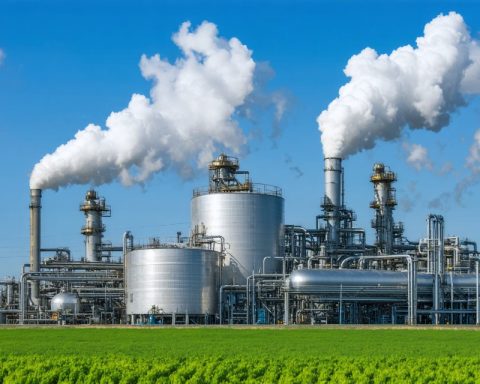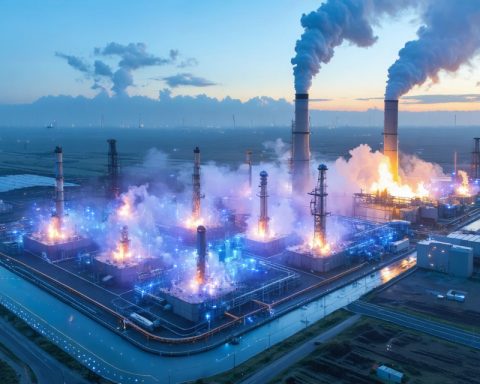The UK’s Energy Landscape is Changing
Blue hydrogen production is emerging as a game-changer for the UK’s energy strategy. According to Nathan Morgan, the CEO of Kellas Midstream, utilizing blue hydrogen, especially in clusters, presents a faster, more cost-effective solution compared to green hydrogen. This innovative approach leverages the existing gas infrastructure, allowing for a seamless transition and greater scalability.
With its versatility, blue hydrogen is positioned to play a crucial role in diversifying the energy mix. The ability to produce it rapidly and at a larger scale will offer the UK a significant advantage as it seeks to meet its climate goals while ensuring energy security. Morgan emphasizes that blue hydrogen can be integrated into current systems, making it a practical option for immediate implementation.
The development of blue hydrogen not only promises economic benefits but also aligns with environmental objectives. By capturing carbon emissions during production, this method minimizes its environmental impact, providing an effective way to transition to cleaner energy sources.
As the UK continues to explore ways to enhance its energy portfolio, blue hydrogen emerges as a pivotal player, offering a straightforward path towards achieving both sustainability and energy reliability. With increased investment and collaboration among industry players, the potential of blue hydrogen could be realized sooner than expected, reshaping the future of the UK’s energy landscape.
Beyond Blue Hydrogen: Examining the Broader Implications of the UK’s Energy Transition
The rise of blue hydrogen in the UK’s energy matrix signifies more than just a technical innovation; it heralds a transformational shift that could redefine societal and economic structures. By harnessing existing infrastructure, this method promises not only to accelerate decarbonization efforts but also to create new job opportunities in regions historically dependent on fossil fuel industries. As the UK pivots towards this energy source, communities may witness revitalization, countering the job losses that will inevitably accompany the decline of coal and oil reliance.
Economically, the blue hydrogen sector is poised to attract substantial investments, which can foster growth in related technological fields such as carbon capture and storage (CCS). In particular, this could bolster the UK’s global position as an energy leader, ultimately influencing international energy prices and trade dynamics. Notably, as Europe grapples with energy security in the wake of geopolitical issues, blue hydrogen could provide a more reliable and regional source of energy, reducing dependence on imports.
Moreover, environmental benefits extend beyond carbon capture. By integrating blue hydrogen production into broader emissions reduction strategies, the UK can improve air quality and contribute to biodiversity preservation—critical components that are often sidelined in energy discourse. As vitally needed legislation and environmental policies evolve, the role of blue hydrogen may expand, driving a long-term commitment to a sustainable future.
In conclusion, as blue hydrogen emerges as a viable energy solution, its implications extend well beyond immediate energy production. This evolving landscape promises to reshape the UK’s cultural and economic fabric, presenting a multifaceted opportunity to foster growth, sustainability, and resilience while simultaneously addressing pressing environmental challenges.
Blue Hydrogen: The Key to a Sustainable Energy Future in the UK
The Changing Energy Landscape in the UK
The UK’s energy strategy is undergoing a significant transformation, and blue hydrogen is at the forefront of this shift. Blue hydrogen, produced through the process of natural gas reforming with carbon capture and storage (CCS), is being recognized as a viable alternative to green hydrogen, particularly in the context of speed and cost-effectiveness.
Benefits of Blue Hydrogen
1. Economic Efficiency
Blue hydrogen utilizes existing natural gas infrastructure, offering a less expensive means of transitioning to cleaner energy. According to experts, the adaptability of blue hydrogen enables a faster rollout than green hydrogen, allowing the UK to ramp up production to meet demand quickly.
2. Environmental Impact
By capturing up to 90% of carbon emissions produced during hydrogen generation, blue hydrogen significantly reduces environmental harm. This makes it a practical step toward the UK’s ambitious climate targets while also ensuring energy security.
Use Cases for Blue Hydrogen
– Industrial Applications: Industries that rely heavily on hydrogen can transition to blue hydrogen with minimal modification to their existing processes. This ensures continuity while reducing carbon footprints.
– Transport Sector: With the burgeoning interest in hydrogen-powered vehicles, blue hydrogen can provide an immediate solution for fueling infrastructure.
– Power Generation: It can complement renewable energy sources, providing a stable supply when wind and solar are insufficient.
Limitations of Blue Hydrogen
While blue hydrogen offers many advantages, it is not without its challenges. The necessity for robust carbon capture technology is critical, and its effectiveness can vary. Additionally, there are concerns regarding the environmental impact of natural gas extraction itself, which needs to be carefully managed.
Market Trends and Predictions
The UK’s commitment to achieving net-zero emissions by 2050 indicates a strong market trend towards hydrogen energy solutions. Analysts predict that investment in blue hydrogen will increase, potentially outpacing green hydrogen investments in the short term due to its immediate scalability and lower costs.
Innovations and Future Developments
With ongoing investments in technology and infrastructure, the blue hydrogen sector is poised for rapid innovation. Companies are exploring novel ways to enhance carbon capture efficiencies and finding new applications for blue hydrogen in various sectors, from residential heating to power generation.
Security Aspects
As the UK transitions towards blue hydrogen, ensuring the security of supply will be paramount. This includes protecting carbon storage facilities and establishing robust logistics for hydrogen distribution to prevent accidents or leaks.
Conclusion
Blue hydrogen stands out as a strategic component of the UK’s energy landscape. Its ability to leverage existing infrastructures while providing economic and environmental benefits makes it a compelling choice for the nation’s energy future. With continued innovation and investment, blue hydrogen could significantly contribute to meeting the UK’s carbon reduction targets, ultimately reshaping the energy sector.
For more insights on energy strategies, visit UK Government Energy Policies for official guidance and information.















